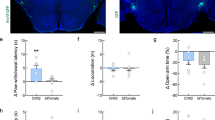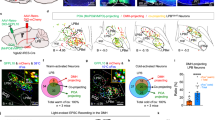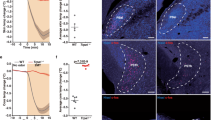Abstract
The aversion to cold is a fundamental motivated behavior that contributes to the body temperature homeostasis. However, the involvement of the lateral habenula (LHb) as a regulatory hub for negative emotions in this physiological process remains uninvestigated. In this study, we demonstrate an elevation in the population activity of LHb neurons following exposure to cold stimuli. Additionally, we establish the necessity of Vglut2-expressing neurons within the LHb for the encoding of cold aversion behaviors. Furthermore, we have elucidated a neural circuit from excitatory neurons of the dorsomedial hypothalamus (DMH) to LHb that plays a crucial role in this progress. Manipulation of the DMH-LHb circuit has a significant impact on cold aversion behavior in mice. It is worth noting that this circuit does not exhibit any noticeable effects on autonomic thermoregulation or depression-like behavior. The identification of these neural mechanisms involved in behavioral thermoregulation provides a promising avenue for future research.







Similar content being viewed by others
Data Availability
Enquiries about data availability should be directed to the authors.
References
Adedokun KA, Olarinmoye AO, Mustapha JO, Kamorudeen RT (2020) A close look at the biology of SARS-CoV-2, and the potential influence of weather conditions and seasons on COVID-19 case spread. Infect Dis Poverty 9:77
Eklund LM, Sköndal Å, Tufvesson E, Sjöström R, Söderström L, Hanstock HG et al (2022) Cold air exposure at – 15 °C induces more airway symptoms and epithelial stress during heavy exercise than rest without aggravated airway constriction. Eur J Appl Physiol 122:2533–2544
Liu C, Yavar Z, Sun Q (2015) Cardiovascular response to thermoregulatory challenges. Am J Physiol Heart Circ Physiol 309:H1793–H1812
Chen R, Yin P, Wang L, Liu C, Niu Y, Wang W et al (2018) Association between ambient temperature and mortality risk and burden: time series study in 272 main Chinese cities. BMJ 363:k4306
Burkart KG, Brauer M, Aravkin AY, Godwin WW, Hay SI, He J et al (2021) Estimating the cause-specific relative risks of non-optimal temperature on daily mortality: a two-part modelling approach applied to the global burden of disease study. Lancet (London England) 398:685–697
Madden CJ, Morrison SF (2019) Central nervous system circuits that control body temperature. Neurosci Lett 696:225–232
Morrison SF, Madden CJ, Tupone D (2014) Central neural regulation of brown adipose tissue thermogenesis and energy expenditure. Cell Metab 19:741–756
Yang S, Tan YL, Wu X, Wang J, Sun J, Liu A et al (2021) An mPOA-ARCAgRP pathway modulates cold-evoked eating behavior. Cell Rep 36:109502
Yahiro T, Kataoka N, Nakamura K (2023) Two ascending thermosensory pathways from the lateral parabrachial nucleus that mediate behavioral and autonomous thermoregulation. J Neurosci. https://doi.org/10.1523/JNEUROSCI.0643-23.2023
Kanai M, Kamiizawa R, Hitora-Imamura N, Minami M (2022) Exposure to hot and cold environments activates neurons projecting from the paraventricular thalamic nucleus to brain regions related to approach and avoidance behaviors. J Therm Biol 103:103157
Li M (2022) Lateral habenula neurocircuits mediate the maternal disruptive effect of maternal stress: a hypothesis. Zool Res 43:166–175
Hitti FL, Parker D, Yang AI, Brem S, Verma R (2022) Laterality and sex differences of human lateral habenula afferent and efferent fiber tracts. Front NeuroSci 16:837624
Metzger M, Souza R, Lima LB, Bueno D, Gonçalves L, Sego C et al (2021) Habenular connections with the dopaminergic and serotonergic system and their role in stress-related psychiatric disorders. Eur J Neurosci 53:65–88
Hu H, Cui Y, Yang Y (2020) Circuits and functions of the lateral habenula in health and in disease. Nat Rev Neurosci 21:277–295
Aizawa H, Kobayashi M, Tanaka S, Fukai T, Okamoto H (2012) Molecular characterization of the subnuclei in rat habenula. J Comp Neurol 520:4051–4066
Hikosaka O, Sesack SR, Lecourtier L, Shepard PD (2008) Habenula: crossroad between the basal ganglia and the limbic system. J Neurosci Off J Soc Neurosci 28:11825–11829
Liu C, Liu J, Zhou L, He H, Zhang Y, Cai S et al (2021) Lateral habenula glutamatergic neurons modulate isoflurane anesthesia in mice. Front Mol Neurosci 14:628996
Zhang B, Gao Y, Li Y, Yang J, Zhao H (2016) Sleep deprivation influences circadian gene expression in the lateral habenula. Behav Neurol 2016:7919534
Zhou W, Jin Y, Meng Q, Zhu X, Bai T, Tian Y et al (2019) A neural circuit for comorbid depressive symptoms in chronic pain. Nat Neurosci 22:1649–1658
Dai D, Li W, Chen A, Gao X-F, Xiong L (2022) Lateral Habenula and its potential roles in pain and related behaviors. ACS Chem Neurosci 13:1108–1118
Nuno-Perez A, Trusel M, Lalive AL, Congiu M, Gastaldo D, Tchenio A et al (2021) Stress undermines reward-guided cognitive performance through synaptic depression in the lateral habenula. Neuron. https://doi.org/10.1016/j.neuron.2021.01.008
Xin J, Shan W, Li J, Yu H, Zuo Z (2022) Activation of the lateral habenula-ventral tegmental area neural circuit contributes to postoperative cognitive dysfunction in mice, vol 9. Advanced Science, Weinheim, p e2202228
Stamatakis AM, Van Swieten M, Basiri ML, Blair GA, Kantak P, Stuber GD (2016) Lateral hypothalamic area glutamatergic neurons and their projections to the lateral habenula regulate feeding and reward. J Neurosci Off J Soc Neurosci 36:302–311
Mondoloni S, Mameli M, Congiu M (2022) Reward and aversion encoding in the lateral habenula for innate and learned behaviours. Transl Psychiatry 12:3
Lazaridis I, Tzortzi O, Weglage M, Märtin A, Xuan Y, Parent M et al (2019) A hypothalamus-habenula circuit controls aversion. Mol Psychiatry 24:1351–1368
Park H, Rhee J, Lee S, Chung C (2017) Selectively impaired endocannabinoid-dependent long-term depression in the lateral habenula in an animal model of depression. Cell Rep 20:289–296
Zhao Z-D, Yang WZ, Gao C, Fu X, Zhang W, Zhou Q et al (2017) A hypothalamic circuit that controls body temperature. Proc Natl Acad Sci USA 114:2042–2047
Feng C, Wang Y, Zha X, Cao H, Huang S, Cao D et al (2022) Cold-sensitive ventromedial hypothalamic neurons control homeostatic thermogenesis and social interaction-associated hyperthermia. Cell Metab 34:888–901
Paxinos G, Franklin KBJ (2008) The mouse brain in stereotaxic coordinates. Academic Press, San Diego
Lin W, Xu L, Zheng Y, An S, Zhao M, Hu W et al (2023) Whole-brain mapping of histaminergic projections in mouse brain. Proc Natl Acad Sci USA 120:e2216231120
Li J, Fan R, Liu X, Shen X, Liu X, Zhao H (2021) The convergence of aversion and reward signals in individual neurons of the mice lateral habenula. Exp Neurol 339:113637
Morrison SF, Nakamura K (2019) Central mechanisms for thermoregulation. Annu Rev Physiol 81:285–308
Kataoka N, Hioki H, Kaneko T, Nakamura K (2014) Psychological stress activates a dorsomedial hypothalamus-medullary raphe circuit driving brown adipose tissue thermogenesis and hyperthermia. Cell Metabol 20:346–358
Nollet M, Gaillard P, Minier F, Tanti A, Belzung C, Leman S (2011) Activation of orexin neurons in dorsomedial/perifornical hypothalamus and antidepressant reversal in a rodent model of depression. Neuropharmacology 61:336–346
Yang Y, Wang H, Hu J, Hu H (2018) Lateral habenula in the pathophysiology of depression. Curr Opin Neurobiol 48:90–96
Tan CL, Knight ZA (2018) Regulation of body temperature by the nervous system. Neuron 98:31–48
Almeida MC, Vizin RCL, Carrettiero DC (2015) Current understanding on the neurophysiology of behavioral thermoregulation. Temperature (Austin Tex) 2:483–490
Roberts WW, Martin JR (1977) Effects of lesions in central thermosensitive areas on thermoregulatory responses in rat. Physiol Behav 19:503–511
Roberts WW, Mooney RD (1974) Brain areas controlling thermoregulatory grooming, prone extension, locomotion, and tail vasodilation in rats. J Comp Physiol Psychol 86:470–480
Lumley LA, Robison CL, Chen WK, Mark B, Meyerhoff JL (2001) Vasopressin into the preoptic area increases grooming behavior in mice. Physiol Behav 73:451–455
Hainsworth FR (1968) Evaporative water loss from rats in the heat. Am J Physiol 214:979–982
Yang WZ, Du X, Zhang W, Gao C, Xie H, Xiao Y et al (2020) Parabrachial neuron types categorically encode thermoregulation variables during heat defense. Sci Adv. https://doi.org/10.1126/sciadv.abb9414
Jung S, Lee M, Kim DY, Son C, Ahn BH, Heo G et al (2022) A forebrain neural substrate for behavioral thermoregulation. Neuron 110:266–279e269
Yahiro T, Kataoka N, Nakamura Y, Nakamura K (2017) The lateral parabrachial nucleus, but not the thalamus, mediates thermosensory pathways for behavioural thermoregulation. Sci Rep 7:5031
Proulx CD, Hikosaka O, Malinow R (2014) Reward processing by the lateral habenula in normal and depressive behaviors. Nat Neurosci 17:1146–1152
Hikosaka O (2010) The habenula: from stress evasion to value-based decision-making. Nat Rev Neurosci 11:503–513
Wang D, Li Y, Feng Q, Guo Q, Zhou J, Luo M (2017) Learning shapes the aversion and reward responses of lateral habenula neurons. ELife. https://doi.org/10.7554/eLife.23045
Rossi MA, Basiri ML, Liu Y, Hashikawa Y, Hashikawa K, Fenno LE et al (2021) Transcriptional and functional divergence in lateral hypothalamic glutamate neurons projecting to the lateral habenula and ventral tegmental area. Neuron 109:3823–3837
Clark BJ, Sarma A, Taube JS (2009) Head direction cell instability in the anterior dorsal thalamus after lesions of the interpeduncular nucleus. J Neurosc Offl J Soc Neurosci 29:493–507
Tran LT, Park S, Kim SK, Lee JS, Kim KW, Kwon O (2022) Hypothalamic control of energy expenditure and thermogenesis. Exp Mol Med 54:358–369
Piñol RA, Zahler SH, Li C, Saha A, Tan BK, Škop V et al (2018) Brs3 neurons in the mouse dorsomedial hypothalamus regulate body temperature, energy expenditure, and heart rate, but not food intake. Nat Neurosci 21:1530–1540
Nakamura K, Morrison SF (2011) Central efferent pathways for cold-defensive and febrile shivering. J Physiol 589:3641–3658
Kokare DM, Dandekar MP, Singru PS, Gupta GL, Subhedar NK (2010) Involvement of alpha-MSH in the social isolation induced anxiety- and depression-like behaviors in rat. Neuropharmacology 58:1009–1018
Cui Y, Huang X, Huang P, Huang L, Feng Z, Xiang X et al (2022) Reward ameliorates depressive-like behaviors via inhibition of the substantia innominata to the lateral habenula projection. Sci Adv 8:eabn0193
Yang Y, Cui Y, Sang K, Dong Y, Ni Z, Ma S et al (2018) Ketamine blocks bursting in the lateral habenula to rapidly relieve depression. Nature 554:317–322
Shabel SJ, Wang C, Monk B, Aronson S, Malinow R (2019) Stress transforms lateral habenula reward responses into punishment signals. Proc Natl Acad Sci USA 116:12488–12493
Lal NK, Le P, Aggarwal S, Zhang A, Wang K, Qi T et al (2023) Xiphoid nucleus of the midline thalamus controls cold-induced food seeking. Nature 621:138–145
Fernández-Peña C, Reimúndez A, Viana F, Arce VM, Señarís R (2023) Sex differences in thermoregulation in mammals: implications for energy homeostasis. Front Endocrinol 14:1093376
Greenfield AM, Alba BK, Giersch GEW, Seeley AD (2023) Sex differences in thermal sensitivity and perception: implications for behavioral and autonomic thermoregulation. Physiol Behav 263:114126
Ye H, Feng B, Wang C, Saito K, Yang Y, Ibrahimi L et al (2022) An estrogen-sensitive hypothalamus-midbrain neural circuit controls thermogenesis and physical activity. Sci Adv 8:eabk0185
Grant AD, Kriegsfeld LJ (2023) Neural substrates underlying rhythmic coupling of female reproductive and thermoregulatory circuits. Front Physiol 14:1254287
Charkoudian N, Stachenfeld N (2016) Sex hormone effects on autonomic mechanisms of thermoregulation in humans. Auton Neuroscience: Basic Clin 196:75–80
Funding
This work was supported by the National Natural Science Foundations of China (81971135; 8217070610; 81801303); Natural Science Foundations of Heilongjiang (YQ2020H014); the “Chunhui Plan” of the Ministry of Education (HLJ2019009); Distinguished Young Foundations of the First Affiliated Hospital of Harbin Medical University (HYD2020JQ0014).
Author information
Authors and Affiliations
Contributions
GY, YS, LW, and RL designed experiments. RL, HX, CL and QJ performed experiments. YL, GW and RL analyzed data. RL, HX, GY and YS wrote the main manuscript text. All authors have reviewed the manuscript.
Corresponding authors
Ethics declarations
Conflict of interest
The authors declare that there are no conflicts of interest.
Ethical Approval
All animal procedures were approved by the Institutional Animal Care and Use Committee of Harbin Medical School, and experiments were performed in accordance to the CPCSEA guidelines for ethical use of animals.
Additional information
Publisher’s Note
Springer Nature remains neutral with regard to jurisdictional claims in published maps and institutional affiliations.
Rights and permissions
Springer Nature or its licensor (e.g. a society or other partner) holds exclusive rights to this article under a publishing agreement with the author(s) or other rightsholder(s); author self-archiving of the accepted manuscript version of this article is solely governed by the terms of such publishing agreement and applicable law.
About this article
Cite this article
Liu, R., Xiang, H., Liu, C. et al. Lateral Habenula Neurons Signal Cold Aversion and Participate in Cold Aversion. Neurochem Res 49, 771–784 (2024). https://doi.org/10.1007/s11064-023-04076-7
Received:
Revised:
Accepted:
Published:
Issue Date:
DOI: https://doi.org/10.1007/s11064-023-04076-7




